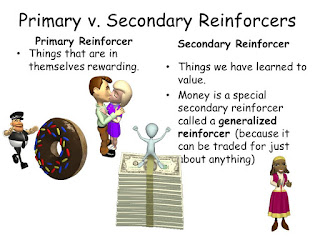Burrhus
Frederic Skinner (commonly known as B. F. Skinner) had coined the term of “operant conditioning”. Skinner, who was the behaviorist in his approach, was born in the United
States of America on 20th March 1904 and died on 18th
August 1990. He had worked at Harvard University as the Edgar Pierce Professor of Psychology.
The term “operant
conditioning” (also called instrumental conditioning) refers to the learning in
which voluntary behavior is strengthened or weakened by consequences or antecedents.
Here, it is worth
mentioning that “antecedents” are the events that precede a behavior or action,
whereas “consequences” are the events that follow an action or behavior.
Skinner believed
that the principles of classical conditioning account for only a small
proportion of learned behaviors. According to him, many human behaviors are
operants, and not respondents. Respondents are elicited by particular stimuli
such as Pavlov bell.
In a respondent
situation, an individual learns merely by being in the situation and responding
to it. Skinner argued that not all behavior is of this type. Most of human
behavior is operant behavior, which is emitted, not elicited.
Before moving
ahead with operant conditioning, let us discuss in brief about classical
conditioning in order to have concept clarity.
Classical
conditioning describes only how existing behaviors might be paired with new
stimuli; however, it does not explain how new operant behaviors are acquired.
In classical
conditioning, behavior (such as response or action) is simply a word for what a
person does in a particular situation. It lies between the antecedents and
consequences.
There is a
relationship in antecedents, behavior, and consequence.
A-----B-----C
Here, “A” stands for
antecedents; “B” stands for behaviors; and “C” stands for consequences.
Now, let’s talk
about the “operant conditioning”.
During the period
of 1930s, B. F. Skinner had started his experiments on “operant conditioning”
(also called instrumental conditioning).
The operant
conditioning is a type of learning in which the strength of a behavior is
modified by the behavior’s consequences (such as reward or punishment); in
which the behavior is controlled by antecedents.
Skinner wanted to
study reinforced responding without breaking the experiments in discrete
trials. In order to study operant conditioning, Skinner had invented the operant conditioning chamber, popularly
known as the Skinner box or Operant Chamber.
An operant chamber is a simple box with device
at one end that can be worked by the animal in the box. For rats, cats, and
monkeys, the device is a lever, and
for pigeon the device is a small panel (called a key) which can be pecked.
The lever and the
key are switches that activate when positive reinforcement is being used. Thus,
positive reinforcement is contingent upon pressing a lever or pecking a key.
The first step in
the operant conditioning of a hungry rat is to get food pellets when they are
delivered by the experimenter who operates the pellet.
The pellets are
delivered one by one; after some that the rate eats each pellet as soon as it
drops. Then, the experimenter stops releasing the pellets and the rat is left
alone in the Skinner box with the lever which will release the pellets.
After an initial
period of inactivity, the hungry rat begins to explore the box. Finally, the
rat presses the level accidentally. A pellet of food is released, i.e. the
reinforcement is contingent upon pressing the lever.
After eating the
food pellet, the rat continues exploring and after a while, it presses the
lever again, and again the pellet is released, then after it presses the lever
the third time.
Usually, after
the fourth and fifth press, the rat begins to press the lever more rapidly and operant
behavior is developed. B.F.
Skinner, who had founded
a school of experimental research psychology (called the “experimental analysis
of behavior”), had preferred the term reinforcement to reward.
According to Skinner, reward is a
subjective interpretation of behavior which is associated with pleasurable
event, whereas reinforcement is
simply defined as an effect that
increases the probability of a response.
Thus, the
experiment on operant conditioning shows that operant behavior can be altered
by changes in the antecedents, the consequences, or both.









